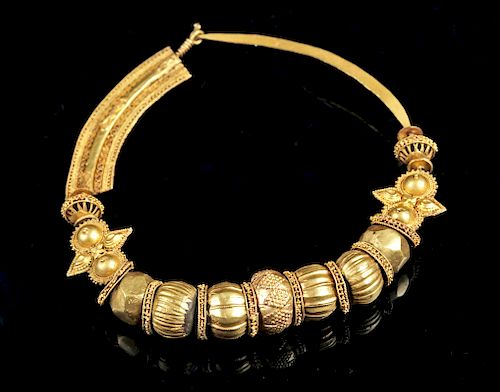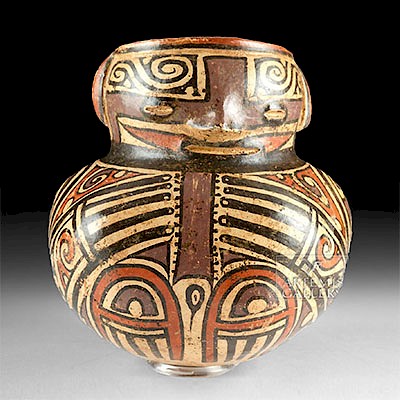Large / Ornate 19th C. Indian 20K Gold Nose Ring - 40 g
Lot 47
About Seller
Artemis Fine Arts
686 S Taylor Ave, Ste 106
Louisville, CO 80027
United States
Selling antiquities, ancient and ethnographic art online since 1993, Artemis Gallery specializes in Classical Antiquities (Egyptian, Greek, Roman, Near Eastern), Asian, Pre-Columbian, African / Tribal / Oceanographic art. Our extensive inventory includes pottery, stone, metal, wood, glass and textil...Read more
Categories
Estimate:
$5,000 - $7,000
Absentee vs Live bid
Two ways to bid:
- Leave a max absentee bid and the platform will bid on your behalf up to your maximum bid during the live auction.
- Bid live during the auction and your bids will be submitted real-time to the auctioneer.
Bid Increments
| Price | Bid Increment |
|---|---|
| $0 | $25 |
| $300 | $50 |
| $1,000 | $100 |
| $2,000 | $250 |
| $5,000 | $500 |
| $10,000 | $1,000 |
| $20,000 | $2,500 |
| $50,000 | $5,000 |
| $100,000 | $10,000 |
| $200,000 | $20,000 |
About Auction
By Artemis Fine Arts
Nov 8, 2018
Set Reminder
2018-11-08 10:00:00
2018-11-08 10:00:00
America/New_York
Bidsquare
Bidsquare : Ancient / Ethnographic From Around The World
https://www.bidsquare.com/auctions/artemis-gallery/ancient-ethnographic-from-around-the-world-3598
Ancient art from Egypt, Greece, Italy and the Near East, as well as Asian, Pre-Columbian, Native American, African / Tribal / Oceanic, Spanish Colonial, Russian Icons, Fine art, much more! Artemis Fine Arts info@artemisgallery.com
Ancient art from Egypt, Greece, Italy and the Near East, as well as Asian, Pre-Columbian, Native American, African / Tribal / Oceanic, Spanish Colonial, Russian Icons, Fine art, much more! Artemis Fine Arts info@artemisgallery.com
- Lot Description
Central Asia, India, ca. late 19th to early 20th century CE. Perhaps the largest and most ornate nose ring (balu) we have ever seen, comprised of very high quality gold (88% gold ~ 20K), adorned by an impressive number of elaborate beads including: 4 ribbed rounded beads; 8 discs with granulated borders; 2 faceted rounded beads; 2 large beads that are each comprised of a pair of hemispheres alternating with teardrop forms, and a central four-petaled motif, all surrounded by a granulated border; 2 openwork urn-shaped beads with granulated passages; a large rounded bead with diamond-shaped clusters of granules; finally, a very large curved band with registers of granules and looped filigree, the central register raised with looped filigree. The long, flat section has a hooked terminal that fits into a loop attached to the arched piece. India has a longstanding tradition of wearing nose rings. Size: 4.25" W (10.8 cm); arched band measures 2.5" L (6.4 cm); Weight: 40 g
A nose ring like this is traditionally used in the Hindu tradition to honor Parvathi, the goddess of marriage, and is also considered a sign of marriage.
Provenance: private House of Indus collection
All items legal to buy/sell under U.S. Statute covering cultural patrimony Code 2600, CHAPTER 14, and are guaranteed to be as described or your money back.
A Certificate of Authenticity will accompany all winning bids.
We ship worldwide and handle all shipping in-house for your convenience.
#138187Some granules missing from long arched piece, disc-shaped beads, and borders of large beads with hemispheres. Recesses of teardrop elements may have once held inlays. Overall quite striking and sizeable!Condition
- Shipping Info
-
All shipping is handled in-house for your convenience. Your invoice from Artemis Gallery will include shipping calculation instructions. If in doubt, please inquire BEFORE bidding for estimated shipping costs for individual items.
-
- Buyer's Premium



 EUR
EUR CAD
CAD AUD
AUD GBP
GBP MXN
MXN HKD
HKD CNY
CNY MYR
MYR SEK
SEK SGD
SGD CHF
CHF THB
THB















